| Listing 1 - 9 of 9 |
Sort by
|
Book
ISBN: 3825378721 9783825378721 9783825369934 3825369935 Year: 2019 Publisher: Heidelberg Universitätsverlag C. Winter
Abstract | Keywords | Export | Availability | Bookmark
 Loading...
Loading...Choose an application
- Reference Manager
- EndNote
- RefWorks (Direct export to RefWorks)
Vom antiken Mythos bis zum postmodernen Horrorgenre dominiert im Hinblick auf das Monströse ein narratives Grundgerüst: Das als destruktiv und horribel vorgestellte Ungeheuer bricht in ein soziokulturelles Gefüge ein, erschüttert es, treibt es im schlimmsten Fall an den Rand des Kollapses, woraufhin ein mehr oder weniger heroischer Protagonist es ver?nicht?et und dadurch die Voraussetzung für die Restitution der Ordnung schafft, an der der teratologische Widersacher allein durch seinen radikalen Ausschluss partizipiert. 0In Abgrenzung zu dieser monsterphoben Tradition ist es das Ziel der Arbeit, auf der Grundlage von Texten Platons, Ovids, Rabelais?, Shelleys, Nietzsches, Freuds, Kafkas, Foucaults und Cixous? einer alternativen, heterodoxen Ästhetik nachzuspüren, die dem Monströsen eine künstlerische wie theoretische ordnungsstiftende Potenz konzediert oder zumindest dem Rezipienten literarische Etüden in Toleranz gegenüber dem Xenomorphen und der Alterität aufgibt.
Monsters in literature. --- Monsters --- Monstres dans la littérature. --- Monstres --- Symbolic aspects. --- Aspect symbolique.
Book

ISBN: 2878548612 2878542797 Year: 2017 Publisher: Paris : Presses Sorbonne Nouvelle,
Abstract | Keywords | Export | Availability | Bookmark
 Loading...
Loading...Choose an application
- Reference Manager
- EndNote
- RefWorks (Direct export to RefWorks)
Ce qui nous est offert ici est une glorieuse galerie de monstres : une naine difforme, un père infanticide souffrant de manie dépressive, un tueur en série amputé d'un bras, un consul presque aveugle, une obèse avachie ou un grand blessé accidenté de la route traversent joyeusement ces pages en compagnie de Sade, de Dracula, et de bien d'autres. Cette grande fantasmagorie du corps difforme ou mutilé justifiait sans doute qu'un ouvrage fut consacré à l'inhumain dans la littérature anglaise et américaine des XIXe et XXe siècles.
English literature --- Monsters in literature. --- Interpersonal relations in literature. --- American literature --- Monstres dans la littérature. --- Atrocités dans la littérature. --- Littérature anglaise --- Littérature américaine --- History and criticism. --- Histoire et critique. --- 20e s. --- Angleterre --- inhumanité --- monstre --- États-Unis --- 19e
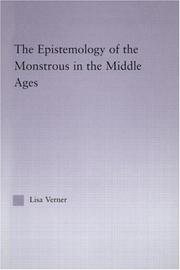
ISBN: 1135873062 0203942612 1135873054 9781135873059 9780415762755 0415762758 0415972434 9780415972437 9780203942611 9781135873011 9781135873066 Year: 2014 Publisher: New York London
Abstract | Keywords | Export | Availability | Bookmark
 Loading...
Loading...Choose an application
- Reference Manager
- EndNote
- RefWorks (Direct export to RefWorks)
English literature --- Monsters in literature. --- Bestiaries --- Animals, Mythical, in literature. --- Monsters --- Travel, Medieval. --- Civilization, Medieval --- Freaks --- Monsters, Double --- Monstrosities --- Animals --- Curiosities and wonders --- Folklore --- History and criticism. --- History --- Abnormalities --- Mandeville, John, --- Littérature anglaise --- Monstres dans la littérature --- Bestiaires --- Animaux fabuleux dans la littérature --- Monstres --- Voyage --- History. --- Histoire et critique --- Histoire
Book
ISBN: 1648892191 9781648892196 Year: 2021 Publisher: Wilmington, Delaware
Abstract | Keywords | Export | Availability | Bookmark
 Loading...
Loading...Choose an application
- Reference Manager
- EndNote
- RefWorks (Direct export to RefWorks)
Monsters --- Monsters in art. --- Monsters in popular culture. --- Monsters in literature. --- Ontologies (Information retrieval) --- Monstres --- Monstres dans l'art. --- Monstres dans la culture populaire. --- Monstres dans la littérature. --- Ontologies (Recherche de l'information) --- Philosophy. --- Symbolic aspects. --- Social aspects. --- Mythology. --- Philosophie. --- Aspect symbolique. --- Aspect social. --- Mythologie.
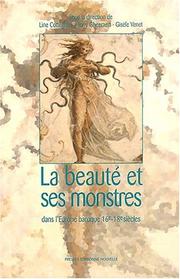
ISBN: 2878542630 2878548477 Year: 2003 Publisher: Paris Presses Sorbonne Nouvelle
Abstract | Keywords | Export | Availability | Bookmark
 Loading...
Loading...Choose an application
- Reference Manager
- EndNote
- RefWorks (Direct export to RefWorks)
Les études réunies sous le titre La beauté et ses monstres sont nées d'un constat de rupture entre l'idéal platonicien qui posait l'alliance étroite du Beau et du Bien et les pratiques esthétiques des XVIe, XVIIe siècles. La poétique baroque, expression d'une crise de la pensée analogique et de l'idéalisme platonicien, procède en effet d'une reconnaissance implicite de la dangereuse contiguïté entre le beau et le monstrueux et trouve son originalité créatrice dans la mise en mouvement de formes « dépravées », dans l'invention de formes qui contreviennent aux lois de la « proportion ». Métamorphoses et anamorphoses jouent de cette virtualité du monstmeux latent en toute forme parfaite qu'un rien peut déformer, déjouant toute tentative de figier des rhétoriques littéraires ou d'immobiliser des genres dans une codification rigoureuse. De même, par l'attraction qu'elle exerce, tant physique que métaphysique, la beauté a suscité la défiance devant l'envers toujours possible de cet attrait, la séduction par une beauté frelatée ou trompeuse. L'étrange et fascinante intimité entre la beauté et ses monstres fonde de la cohérence d'une dynamique de recherche par-delà la variété des angles d'analyse adoptés et la contiguïté entre le beau et le monstrueux apparaît bel et bien comme facteur supplémentaire d'unité dans l'expression de la sensibilité baroque. Ce volume, à ce titre, est une contribution à l'histoire d'une esthétique liée à cette sensibilité et aux paradoxes par lesquels elle trouve à s'exprimer, paradoxes qu'implique la saisie unifiée d'éléments contradictoires. C'est une illustration de plus, s'il en fallait, d'une crise de la représentation qui a trouvé dans une esthétique de la discordia concors ou de la coincidentia oppositorum sa réponse la plus pertinente, sa « monstrueuse beauté »
Aesthetics of art --- Art styles --- Literature --- anno 1700-1799 --- anno 1600-1699 --- anno 1500-1599 --- Europe --- Monsters in literature --- Beauty, Personal, in literature --- Monsters in art --- Beauty, Personal, in art --- Baroque literature --- Arts, European --- Monstres dans la littérature --- Beauté corporelle dans la littérature --- Monstres dans l'art --- Beauté corporelle dans l'art --- Littérature baroque --- Arts européens --- Congresses. --- Congresses --- History and criticism --- Congrès --- Histoire et critique --- Monstres dans la littérature --- Beauté corporelle dans la littérature --- Beauté corporelle dans l'art --- Littérature baroque --- Arts européens --- Congrès --- esthétique --- monstres --- histoire --- beauté --- 16-18e --- Baroque
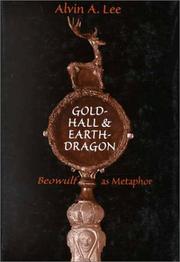
ISBN: 080204378X 1442613122 9786612028755 1282028758 1442675403 9781442675407 9781282028753 9780802043788 Year: 1998 Publisher: Toronto
Abstract | Keywords | Export | Availability | Bookmark
 Loading...
Loading...Choose an application
- Reference Manager
- EndNote
- RefWorks (Direct export to RefWorks)
The aim of Gold-Hall and Earth -Dragon is to re-create as fully as possible for modern readers the original force of the poetic language of Beowulf. Lee makes use of a wide, archetypal literary context for Beowulf to provide illuminating parallels and contrasts with poems and fictions from other times and places. He demonstrates how the poem's symbolic system reveals itself through the metaphorical workings of the Old English words, patterns of imagery, and more general narrative structures, and how the poem might have been experienced and interpreted by the Anglo-Saxons in the light of other Old English poems. The critical tools that Lee uses - combining certain techniques of New Criticism and close reading with postmodern theories of the self-referentiality of language and with Northrop Frye's conceptions of structure and polysemy in literature - make possible a fresh new account of Beowulf as a work that is very much alive in its poetic language, a finely wrought symbolic work of imagining, still resonant with meanings old and new.
Epic poetry, English (Old) --- English language --- Scandinavia in literature. --- Civilization, Anglo-Saxon. --- Monsters in literature. --- Dragons in literature. --- Heroes in literature. --- Rhetoric, Medieval. --- Metaphor. --- Poésie épique anglaise --- Anglais (Langue) --- Scandinavie dans la littérature --- Civilisation anglo-saxonne --- Monstres dans la littérature --- Dragons dans la littérature --- Héros dans la littérature --- Rhétorique médiévale --- Métaphore --- History and criticism. --- Vieil anglais --- Histoire et critique --- Beowulf. --- Parabole --- Anglo-Saxon civilization --- Anglo-Saxons --- Lexicology. --- Style. --- Civilization --- Bjowulf --- Scandinavia --- In literature. --- Figures of speech --- Reification --- Germanic languages --- Poésie épique anglaise --- Scandinavie dans la littérature --- Monstres dans la littérature --- Dragons dans la littérature --- Héros dans la littérature --- Rhétorique médiévale --- Métaphore
Book
ISBN: 9789004278370 9004278370 9789004283626 9004283625 1322348812 Year: 2015 Volume: 376 Publisher: Leiden
Abstract | Keywords | Export | Availability | Bookmark
 Loading...
Loading...Choose an application
- Reference Manager
- EndNote
- RefWorks (Direct export to RefWorks)
In Figures de l’épouvante grecques de l’antiquité au présent , Maria Patera examines an unfamiliar aspect of the Greek pedagogy of fear, illustrated by narratives about four Greek terrifying figures: Lamia, Mormô, Gellô and Empousa. These female bogeys belong to the children's world. Each of those figures provokes fear in a particular way, according to its own characteristics (metamorphosis, hybridity, cannibalism, et cetera). By means of a diachronic comparison of the ancient figures with their Byzantine and modern Greek namesakes, each of them is assigned a proper position within its specific historical, cultural, and religious context. Dans Figures de l’épouvante grecques de l’antiquité au présent , Maria Patera examine un aspect mal connu de la pédagogie grecque, celui de la peur, illustré à travers des récits principalement destinés aux enfants à propos des épouvantails Lamia, Mormô, Gellô et Empousa. Ces quatre figures féminines appartiennent aux chambres enfantines et aux contes de bonnes femmes. Chacune d’entre elles matérialise un aspect de l’épouvante à travers ses façons d’agir et ses traits caractéristiques (métamorphose, hybridité, anthropophagie, et cetera). Un examen diachronique permet de comparer les personnages anciens à leurs homonymes byzantins et néo-grecs et de déterminer leurs fonctions respectives dans chaque contexte historique, religieux et culturel donné.
Greek literature --- Byzantine literature --- Fear in literature. --- Children in literature. --- Ghosts in literature. --- Monsters in literature. --- Mythology, Greek --- Littérature grecque --- Littérature byzantine --- Peur dans la littérature --- Enfants dans la littérature --- Fantômes dans la littérature --- Monstres dans la littérature --- Mythologie grecque --- History and criticism. --- Psychological aspects --- Histoire et critique --- Aspect psychologique --- Fear in literature --- Children in literature --- Goddesses, Greek, in literature --- Ghosts in literature --- Monsters in literature --- History and criticism --- Littérature grecque --- Littérature byzantine --- Peur dans la littérature --- Enfants dans la littérature --- Fantômes dans la littérature --- Monstres dans la littérature --- Goddesses, Greek, in literature. --- Childhood in literature --- Children in poetry --- Greek literature - History and criticism --- Byzantine literature - History and criticism --- Mythology, Greek - Psychological aspects
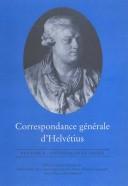
ISBN: 0802055176 0802027784 0802056415 0802089917 9781442673502 1442673508 9780802055170 9780802056412 9780802027788 0729405532 9780729405539 1282039490 9786612039492 1442638818 1442638826 1442683856 0802087191 1442638842 9786611992804 1442673524 1281992801 0802086675 9780802089915 9781442673526 0729406164 9780729406161 9781442683853 1442654244 1442654252 1442654279 Year: 2004 Volume: 41, 51, 63 Publisher: Toronto, [Ontario] ; Buffalo, [New York] : University of Toronto Press,
Abstract | Keywords | Export | Availability | Bookmark
 Loading...
Loading...Choose an application
- Reference Manager
- EndNote
- RefWorks (Direct export to RefWorks)
This fifth and final volume completes the critical edition of the letters of French philosopher Claude Adrien Helvetius (1715-1771), author of the controversial De l'Esprit (1758), and of his wife, nee Anne Catherine de Ligniville (1722-1800), who ran her own salon in Auteuil after her husband's death. The essential component in this last volume is the detailed index - an indispensable instrument for researchers who wish to make full use of the correspondence. The volume also includes four new letters discovered since the appearance of the first four volumes, errata, additions and modifications to the critical apparatus, the text of letters excluded from the edition proper, genealogies of the families of Helvetius and his wife, and a chronological list of all letters mentioned in the edition.
Philosophers --- Helvetius, --- -Correspondence --- Helvetius --- Philosophes --- Correspondence --- Correspondance --- Helvétius, --- -Scholars --- Helvétius, Claude Adrien, --- LITERARY COLLECTIONS / Letters. --- Helvétius, Claude-Adrien, --- Gelʹvet︠s︡iĭ, K., --- Гельвеций, К., --- Schweitzer, Claude-Adrien, --- Helwecjusz, --- Criticism and interpretation. --- French literature --- English literature --- Monsters in literature --- Literature, Medieval --- Monsters in art --- Littérature anglaise --- Monstres dans la littérature --- Littérature médiévale --- Monstres dans l'art --- History and criticism --- Histoire et critique --- Monsters in literature. --- Monsters --- Monsters in art. --- History and criticism. --- Symbolic aspects --- History --- Philosophers - France - Correspondence --- Helvétius, Claude Adrien, - 1715-1771 --- France. --- Helvetius, Anne-Catherine, --- Bro-C'hall --- Fa-kuo --- Fa-lan-hsi --- Faguo --- Falanxi --- Falanxi Gongheguo --- Farans --- Farānsah --- França --- Francia (Republic) --- Francija --- Francja --- Francland --- Francuska --- Franis --- Franḳraykh --- Frankreich --- Frankrig --- Frankrijk --- Frankrike --- Frankryk --- Fransa --- Fransa Respublikası --- Franse --- Franse Republiek --- Frant͡ --- Frant͡s Uls --- Frant͡sii͡ --- Frantsuzskai͡a Rėspublika --- Frantsyi͡ --- Franza --- French Republic --- Frencisc Cynewīse --- Frenska republika --- Furansu --- Furansu Kyōwakoku --- Gallia --- Gallia (Republic) --- Gallikē Dēmokratia --- Hyãsia --- Parancis --- Peurancih --- Phransiya --- Pransiya --- Pransya --- Prantsusmaa --- Pʻŭrangs --- Ranska --- República Francesa --- Republica Franzesa --- Republika Francuska --- Republiḳah ha-Tsarfatit --- Republikang Pranses --- République française --- Tsarfat --- Tsorfat --- Helvétius, Anne Catherine de Ligniville d'Autricourt, --- De Ligniville d'Autricourt, Anne-Catherine, --- Ligniville d'Autricourt, Anne-Catherine de, --- D'Autricourt, Anne-Catherine de Ligniville, --- Autricourt, Anne-Catherine de Ligniville d', --- Gelʹvet͡siĭ, K.,
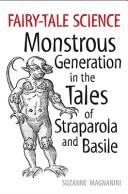
ISBN: 9780802097545 0802097545 1442688084 9781442688087 9781442692374 1442692375 Year: 2008 Publisher: Toronto, Ont. University of Toronto Press
Abstract | Keywords | Export | Availability | Bookmark
 Loading...
Loading...Choose an application
- Reference Manager
- EndNote
- RefWorks (Direct export to RefWorks)
"In Fairy-Tale Science Suzanne Magnanini explores the birth and evolution of the literary fairy tale in the context of early modern discourses on the monstrous. She demonstrates how both the normative literary theories of the Italian intellectual establishment and the emerging New Science limited the genre's success on its native soil. Natural philosophers, physicians, and clergymen positioned the fairy tale in opposition to science, fixing it as a negative pole in a binary system, one which came to define both a new type of scientific inquiry and the nascent literary genre. Magnanini also suggests that, by identifying their literary production with the monstrous and the feminine, Straparola and Basile contributed to the marginalization of the new genre." "A wide-ranging yet carefully crafted study, Fairy-Tale Science investigates the complex interplay between scientific discourse and an emerging literary genre, and expands our understanding of the early modern European imagination."--Jacket.
Monsters --- Fairy tales --- Literature and science --- Monsters in literature. --- Italian fiction --- Monstres --- Contes de fées --- Littérature et sciences --- Monstres dans la littérature --- Roman italien --- Folklore. --- History. --- History and criticism. --- Folklore --- Histoire et critique --- Histoire --- Straparola, Giovanni Francesco, ca. 1480-1557? --- Basile, Giambattista, --- Criticism and interpretation. --- Straparola, Giovanni Francesco, --- Freaks --- Monsters, Double --- Monstrosities --- Abbattutis, Gian Alesio, --- Basile, Giovanni Battista, --- באסילע, זשיאן באטיסטא --- באסילע, זשיאן באטיסטא, --- Straparola, Gian Francesco, --- Straparola, Giovan Francesco, --- Straparola, Giovanfrancesco, --- Straparola, Giovani Francesco, --- Straparole, J.-F. --- Straparole, Jean-François, --- Straparole, --- Italian literature --- Animals --- Curiosities and wonders --- Poetry and science --- Science and literature --- Science and poetry --- Science and the humanities --- Fairytales --- Children's stories --- Tales --- Abnormalities --- Basile, Giovan Battista, --- Thematology --- Basile, Giambattista --- Straparole, Jean François --- Italy. --- Italia --- Italian Republic --- Italianska republika --- Italʹi͡anskai͡a Rėspublika --- Italie --- Italien --- Italii͡ --- Italii͡a Respublikasi --- Italiĭsʹka Respublika --- Itālija --- Itālijas Republika --- Italijos Respublika --- Italikē Dēmokratia --- Īṭāliy --- Italiya Respublikasi --- It'allia --- It'allia Konghwaguk --- İtalya --- İtalya Cumhuriyeti --- Iṭalyah --- Iṭalye --- Itaria --- Itaria Kyōwakoku --- Jumhūrīyah al-Īṭālīyah --- Kgl. Italienische Regierung --- Königliche Italienische Regierung --- Laško --- Lýðveldið Ítalía --- Olasz Köztársaság --- Olaszország --- Regno d'Italia --- Repubblica italiana --- Republiḳah ha-Iṭalḳit --- Włochy --- Yidali --- Yidali Gongheguo --- Italy
| Listing 1 - 9 of 9 |
Sort by
|

 Search
Search Feedback
Feedback About UniCat
About UniCat  Help
Help News
News